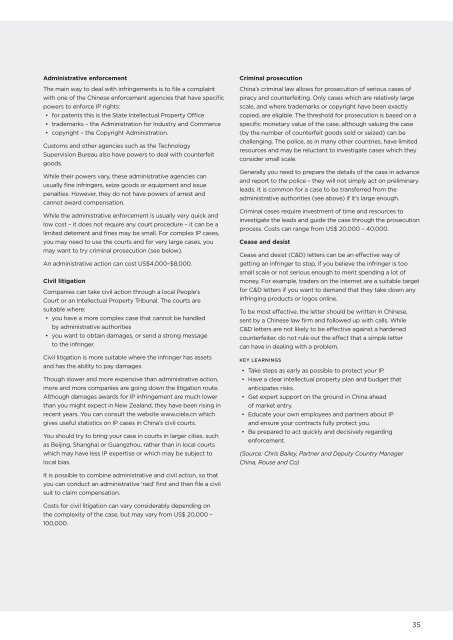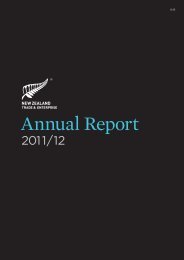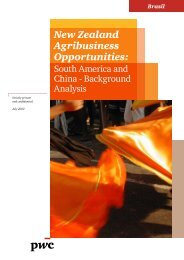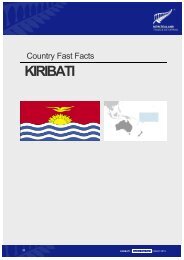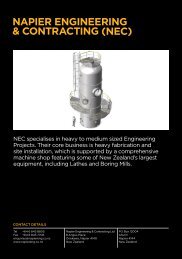Navigating China Guide (2012) - New Zealand Trade and Enterprise
Navigating China Guide (2012) - New Zealand Trade and Enterprise
Navigating China Guide (2012) - New Zealand Trade and Enterprise
You also want an ePaper? Increase the reach of your titles
YUMPU automatically turns print PDFs into web optimized ePapers that Google loves.
Administrative enforcement<br />
The main way to deal with infringements is to file a complaint<br />
with one of the Chinese enforcement agencies that have specific<br />
powers to enforce IP rights:<br />
• for patents this is the State Intellectual Property Office<br />
• trademarks – the Administration for Industry <strong>and</strong> Commerce<br />
• copyright – the Copyright Administration.<br />
Customs <strong>and</strong> other agencies such as the Technology<br />
Supervision Bureau also have powers to deal with counterfeit<br />
goods.<br />
While their powers vary, these administrative agencies can<br />
usually fine infringers, seize goods or equipment <strong>and</strong> issue<br />
penalties. However, they do not have powers of arrest <strong>and</strong><br />
cannot award compensation.<br />
While the administrative enforcement is usually very quick <strong>and</strong><br />
low cost – it does not require any court procedure – it can be a<br />
limited deterrent <strong>and</strong> fines may be small. For complex IP cases,<br />
you may need to use the courts <strong>and</strong> for very large cases, you<br />
may want to try criminal prosecution (see below).<br />
An administrative action can cost US$4,000–$8,000.<br />
Civil litigation<br />
Companies can take civil action through a local People’s<br />
Court or an Intellectual Property Tribunal. The courts are<br />
suitable where:<br />
• you have a more complex case that cannot be h<strong>and</strong>led<br />
by administrative authorities<br />
• you want to obtain damages, or send a strong message<br />
to the infringer.<br />
Civil litigation is more suitable where the infringer has assets<br />
<strong>and</strong> has the ability to pay damages.<br />
Though slower <strong>and</strong> more expensive than administrative action,<br />
more <strong>and</strong> more companies are going down the litigation route.<br />
Although damages awards for IP infringement are much lower<br />
than you might expect in <strong>New</strong> <strong>Zeal<strong>and</strong></strong>, they have been rising in<br />
recent years. You can consult the website www.ciela.cn which<br />
gives useful statistics on IP cases in <strong>China</strong>’s civil courts.<br />
You should try to bring your case in courts in larger cities, such<br />
as Beijing, Shanghai or Guangzhou, rather than in local courts<br />
which may have less IP expertise or which may be subject to<br />
local bias.<br />
Criminal prosecution<br />
<strong>China</strong>’s criminal law allows for prosecution of serious cases of<br />
piracy <strong>and</strong> counterfeiting. Only cases which are relatively large<br />
scale, <strong>and</strong> where trademarks or copyright have been exactly<br />
copied, are eligible. The threshold for prosecution is based on a<br />
specific monetary value of the case, although valuing the case<br />
(by the number of counterfeit goods sold or seized) can be<br />
challenging. The police, as in many other countries, have limited<br />
resources <strong>and</strong> may be reluctant to investigate cases which they<br />
consider small scale.<br />
Generally you need to prepare the details of the case in advance<br />
<strong>and</strong> report to the police – they will not simply act on preliminary<br />
leads. It is common for a case to be transferred from the<br />
administrative authorities (see above) if it’s large enough.<br />
Criminal cases require investment of time <strong>and</strong> resources to<br />
investigate the leads <strong>and</strong> guide the case through the prosecution<br />
process. Costs can range from US$ 20,000 – 40,000.<br />
Cease <strong>and</strong> desist<br />
Cease <strong>and</strong> desist (C&D) letters can be an effective way of<br />
getting an infringer to stop, if you believe the infringer is too<br />
small scale or not serious enough to merit spending a lot of<br />
money. For example, traders on the internet are a suitable target<br />
for C&D letters if you want to dem<strong>and</strong> that they take down any<br />
infringing products or logos online.<br />
To be most effective, the letter should be written in Chinese,<br />
sent by a Chinese law firm <strong>and</strong> followed up with calls. While<br />
C&D letters are not likely to be effective against a hardened<br />
counterfeiter, do not rule out the effect that a simple letter<br />
can have in dealing with a problem.<br />
KEY LEARNINGS<br />
• Take steps as early as possible to protect your IP.<br />
• Have a clear intellectual property plan <strong>and</strong> budget that<br />
anticipates risks.<br />
• Get expert support on the ground in <strong>China</strong> ahead<br />
of market entry.<br />
• Educate your own employees <strong>and</strong> partners about IP<br />
<strong>and</strong> ensure your contracts fully protect you.<br />
• Be prepared to act quickly <strong>and</strong> decisively regarding<br />
enforcement.<br />
(Source: Chris Bailey, Partner <strong>and</strong> Deputy Country Manager<br />
<strong>China</strong>, Rouse <strong>and</strong> Co)<br />
It is possible to combine administrative <strong>and</strong> civil action, so that<br />
you can conduct an administrative ‘raid’ first <strong>and</strong> then file a civil<br />
suit to claim compensation.<br />
Costs for civil litigation can vary considerably depending on<br />
the complexity of the case, but may vary from US$ 20,000 –<br />
100,000.<br />
35


